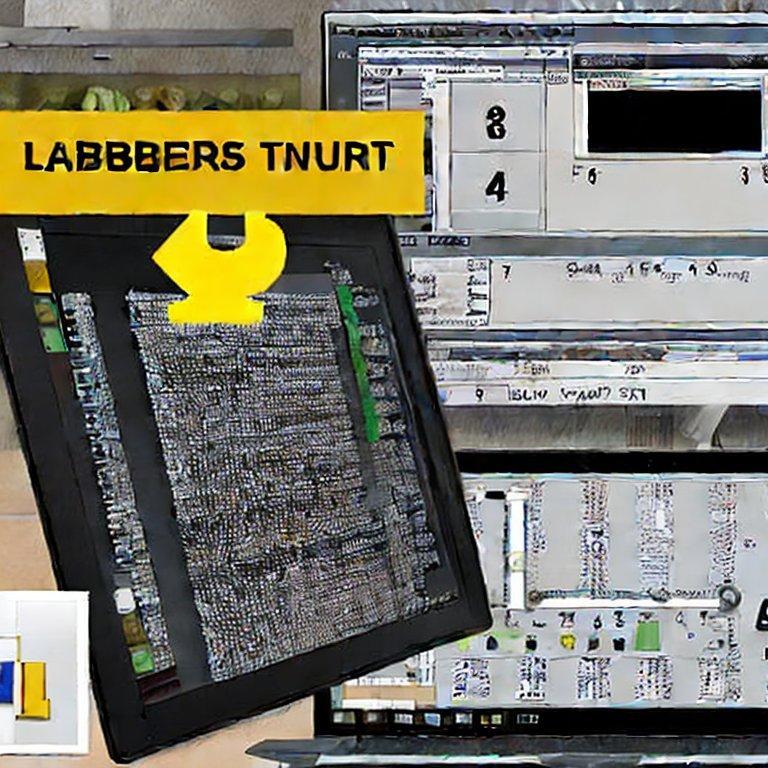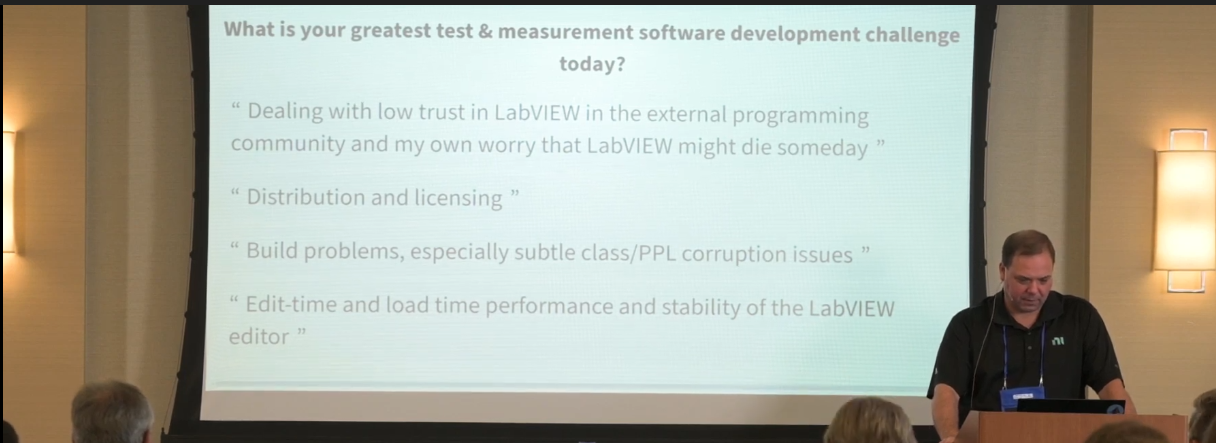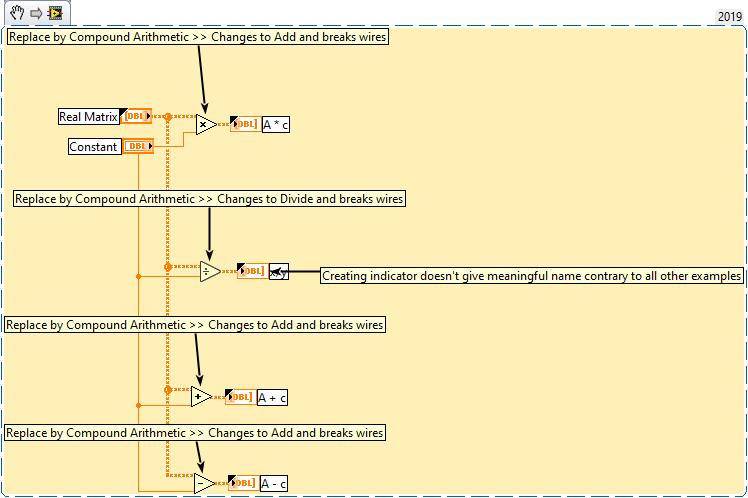-
Posts
440 -
Joined
-
Days Won
29
Content Type
Profiles
Forums
Downloads
Gallery
Everything posted by X___
-

I am taking a sabbatical from LabVIEW and NI R&D
X___ replied to Aristos Queue's topic in LAVA Lounge
-
I'd agree with that, which makes the call for input on the subscription all the more dubious.
-
Some feedback requested on NI's forums, from the very person who "explained" why NXG was killed.
-
I installed the G Web Development Software on August 2021 (not sure why I still have it installed, as I realized that I still had no use for it in the state it is in): no expiration date. On the other hand, I installed the LabVIEW Analytics and Machine Learning Toolkit, Version 2018, in November of that same year and it has that same expiration date of August 18, 2022.
-
https://en.wikipedia.org/wiki/Age_of_the_captain
-
I called "NI" and... ended up talking with my email interlocutor! The long and short of it is that indeed the NI License Manager is mixing up concepts (usage of a version and software support). "NI" herself admitted that she had never looked at a NI License Manger screenshot like the one I sent her, and would pass on the feedback (to clarify and be consistent). We know how this one will end... Moreover, at this time, the number of installations (under the upcoming licensing scheme) will not be monitored, whether locally or at NI (but don't hold your breath). Finally, although I am not planning to test that myself, it would appear that the license serial number (academic at least) will change every year. But then maybe it won't...
-
Here is NI's (verbatim) response (it is literally signed "NI"): "The number of 176 day reamaining, it is the time you have until your active license expire, I can assure you that version 2021 SP1 will continue to work after the license expires. Please review the following link with more information: https://knowledge.ni.com/KnowledgeArticleDetails?id=kA03q000000YSO4CAO&l=en-US The other think is about the code I am no an expert on that, please read the information on the link and if is necessary you can call tech suppoort. Let me know if this helps you or if you have any other question. Regards NI" So the so-called "perpetual" license expires...but the software still works afterwards. And of course the provided link as absolutely nothing to do with the age of the captain.Time to call (877) 388-1952.
-
What's the logic of that? And what does this mean exactly? That on August 2022, LV 2021 SP1 will suddenly stop working unless I reactivate it? That a warning will pop-up until I reactivate each time I launch LV? Sounds more like a perpetual license to annoy the user...
-
Actually my main problem is not the grammar but the lack of clarity. Installing 2021 SP1 shows "176 days" remaining before the license expires (in the license manager), or an "expiration" date of August 2022 (our Department renewed in August last year). I am willing to interpret this as "SSL license leftover duration", but I wonder what that would be doing in the license manager? Same goes for Vision Development 2021, VI Analyzer 2021. Is this is a permanent license or not, that is the question... Older versions do not show anything in the "expiration" date column. Back to NI support.
-
To add some "clarity" to this mud soup, here is the (verbatim) answer I got regarding our academic license (renewed some time last year) and whether or not I could upgrade to 2021 SP1 now without risking to lose access to my code when my Department decides that the investment in an annual license is too costly: "Dear Customer, Thank you for contacting NI I would like to help you to clarify some information, we can not cancel your Licenses since they are perpetual, what this change means is for these products is that we will not be able to renew its service contract. In order to get again the secondary license for students, access to software updates, technical support and the rest of online services we will need to license you under the new subscription model, but you can still use it. Reviewing your Serial Number, if you don't renew this year and don't want to change to subscription the last version that you can use is the 2021 SP1, you should not have any problem using the 2021 version, since is the last one that you have access." So I "should not have any problem"... unless I do, that is, maybe?
-

I am taking a sabbatical from LabVIEW and NI R&D
X___ replied to Aristos Queue's topic in LAVA Lounge
NI is publicly traded and is of course entitled to promote any "forward looking" image of itself as suits its needs. Fundamentally though, there is a difference between the hardware sale expanding and, because it is associated with a LabVIEW sale, a concomitant increase of the "user base", and a language adoption increase. The type of reaction of text programmers to LabVIEW is predictable and hasn't changed in decades. They will revert to text-based development once they realize that drivers exists for their preferred language. The feeling that is expressed here, from long time LabVIEW developers, is that LabVIEW is stale and, after the NXG debacle, dead. There is absolutely no benefit for a new comer to invest the time and effort to become proficient in a development environment that is stuck in 20...10? -

I am taking a sabbatical from LabVIEW and NI R&D
X___ replied to Aristos Queue's topic in LAVA Lounge
Interesting perspective... But on the other hand, it is probably too late to worry about external G developers leaving G. 😒 -
...
-
I am using the Compound Arithmetic operator as much as possible. It took me some time to figure out that it is not yet working with matrices. As a side note, the Indicator naming algorithm has problems with the Divide operator (or the ither 3 do wonder to figure out that one input is a matrix 'A' and the other is a constant 'c") 0
-
I can see why it is defunct... Personally, I would settle with fixing all the decade long bugs and having support be more useful than it has been my experience. Kind of gnaws at one's desire to engineer ambitiously when one has to hack around bugs or longstanding issues.
-
What are you referring to? "futuristic" features or "super-futuristic" features? Personally, Colonel Kodosky's vision scares the bejesus out of me. I imagine an application whose diagram contains a single icon of itself, which when you click into it, sucks you into the matrix and shreds you to bits... I mean wires.
-
And meanwhile, Colonel Kodosky is mulling the future of LabVIEW in his fortified Texas compound...
-

Challenge: figure out why this loop doesn't stop
X___ replied to Sparkette's topic in LabVIEW General
Replacing the Subtract operator by the Compound Arithmetic one fixes the sickness. -

Failure to run a LabVIEW 2021 standalone app on macOS Monterey
X___ replied to X___'s topic in Apple Macintosh
Thanks. Not an utter surprise considering that an Intel MBP running Monterey wasn't able to run the standalone either (but runs the development version just fine).- 10 replies
-
- appbuilder
- labview 2021
-
(and 1 more)
Tagged with:
-

Failure to run a LabVIEW 2021 standalone app on macOS Monterey
X___ replied to X___'s topic in Apple Macintosh
@mahgust BTW, my problem was not to run this standalone app on a M1 machine. The target was an Intel MBP running Monterey. Running it on M1 silicon would be even less likely to work. This being said, if you manage to get it to work, that would be a useful datapoint for me (NI is clueless and doesn't seem to be able to read my report correctly, so I gave up on them).- 10 replies
-
- appbuilder
- labview 2021
-
(and 1 more)
Tagged with:
-

Failure to run a LabVIEW 2021 standalone app on macOS Monterey
X___ replied to X___'s topic in Apple Macintosh
I am attaching the app (released on a MBP running Catalina). FRETX4.app.zip- 10 replies
-
- appbuilder
- labview 2021
-
(and 1 more)
Tagged with:
-
I doubt it. They never asked me for my code, and never answered my questions as to what my failure logs were telling them. Honestly, I had the feeling they really did not care beside just raking the number of support hours they are supposed to log per month. But it's just my disappointed customer opinion, obviously.
-
We shall see about that. Having to subscribe to get a bug fix release would be the nail in the coffin in my not so humble opinion. But in any case, I am fine with 2019 SP1 as I have no use for secure HTTP. The recommendation to upgrade by the NI engineers I dealt with to solve (and eventually did not solve) my recent problems, take a fresh new perspective in this context! At the time that sounded to me like a stupid advice. Now it sounds like a sneaky marketing ploy...
-
Discussing the new SaaS LabVIEW model with the IT officer in charge of paying for our Departmental subscription, it dawned on to me that they could very conceivably decide not to continue paying for our license at any point in the future, due to the dwindling demand for LabVIEW in industry (and increasing pull to Python and other alternative). This would leave us peons to have to shell for individual seat licenses from our meager federal grants, something that is not sustainable. In other words, I have concluded that I will try out LV 2021 SP1 when it is released (presumably not yet SaaS), and if no major bugs prevent me from working with it, I will stop there and start migrating all my applications to py-prefix named ones. Otherwise, I will stick to LV 2019 and do the same. To each his/her/their own ambition, I guess.






